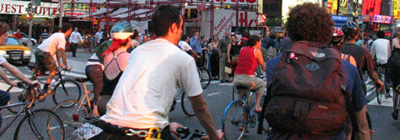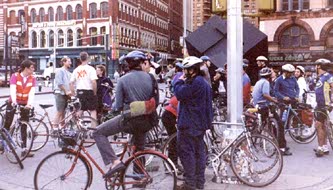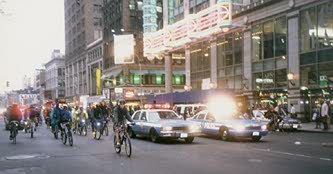Critical Mass is an event that began in San Francisco in
the early 1990s and has since spread to hundreds of cities around the
world. It usually occurs monthly (sometimes weekly). as bicyclists
spontaneously come together to ride the ordinarily car-clogged streets
of their cities. Critical Mass focuses on the rights of bicyclists
and the rights of pedestrians on our own streets. It also brings
attention to the deteriorating quality of life — starting with the
toxic levels of air and noise pollution — that cars create for
cities.

It is a leaderless ride, free and open to all, where bicyclists
take to the streets to promote bicycling as the best means of urban
transit.
Bicyclists are just as much traffic and have just as much right to
be on the roads and travel at their own speed as anyone else. Having
said that, TIME’S UP! recommends all road users obey all New York
City traffic laws, especially one-way street restrictions and
traffic lights. Remember, the respect we seek as cyclists must be
matched by our respect for the rights of other people, including
pedestrians and drivers.

Critical Mass is a bike ride, not an organization, and no two riders
participate for exactly the same reason. “What is Critical Mass?” is
a question that has as many answers as participants. The only real
way to answer the question is to join the ride yourself. So what are
you waiting for?
Critical Mass in New York City
New York City’s Critical Mass was a successful strategy for increasing bicycling and creating safe city infrastructure. It encouraged new riders and empowered them to become daily commuters through safe, fun group bike rides. The rides changed the city forever.
In the 1990’s, car culture dominated New York City, and bicycling was extremely unsafe. It was not uncommon for cars to purposely knock you off the road.
Around 1995, TIME’S UP! Environmental Organization began devising strategies that would increase biking and non-polluting transportation in the city. These included hundreds of beginner bike rides in safe places like through Central Park, Prospect Park, and greenway rides. The number one complaint from cyclists was that they didn’t feel safe, and group rides helped to both build a sense of community and the confidence of new cyclists, inspiring them to become everyday commuters.
As these rides began to help expand bicycling, TIME’S UP! helped to promote and organize the Critical Mass bike ride, an event that, by the end of 2003, was held in over 300 cities around the world–usually on the last Friday of every month. It met at the Washington Square Park Arch, followed by the Astor Place Cube, and then, when it got really large, at Union Square Park North.
At the same time, TIME’S UP! demonstrated to get cars out of Herald Square and Times Square, did traffic calming rides on a weekly basis in Central Park, and promoted the new greenway infrastructure. TIME’S UP! was also involved and organized a bicycle co-op where people could fix their own bikes and learn how they worked. The organization also helped to start New York City’s pedicab business. However, ultimately, Critical Mass was the game changer, continuously increasing bicycling in the city. When it reached a thousand bicyclists, there was a high chance that a hundred were new riders. So as long as we kept Critical Mass going, biking would continue to increase at a crucial juncture in the city’s history.
New York City did everything they possibly could to discourage group bike rides and Critical Mass, including ticketing and arresting thousands of bicyclists. The city proceeded to harass TIME’S UP! and other groups with lawsuits and threats. Many other bicycling groups sat on the sidelines during this crucial growth period, intimidated by the city’s bullying behavior. TIME’S UP! continued to support Critical Mass and other group rides, despite the intense harassment from the New York City Police Department. Eventually, we were able to reach biking’s critical mass in New York City, and now it can’t go back to the way it was.
The increase in bicycling put pressure on the city to create the infrastructure that we now see today: bike lanes, auto-free plazas, greenways, and auto-free parks. Special thanks to all the bicyclists that rode during this crucial time in New York City’s history. We created a permanently more safe, sustainable, and livable city.
Critical Mass FAQ
(For New York City)
 The Manhattan Mass used to
The Manhattan Mass used togather at the cube
in Astor Place.
Q. How long is the ride?
A. It lasts for one to two hours, finishing either where we started
or at an event, such as a party. In distance, it’s usually not more
than ten miles, through well-travelled city streets. Rides tend to
be longer in the summer and shorter in the winter.
Q. Where does the ride go?
A. Rides go wherever the mood of the ride brings them. There is no
set route, so the people at the front tend to decide by consensus
where the next turn will be.
Q. Do I need a special bike for the Critical Mass Ride?
A. No. Any bike will do. People use ten speeds, BMX bikes, tandems,
fold-ups, cruisers, and all manners of bicycles. It’s often fun going
just to see the different types of bicycles you’ll see!
| Xerocracy: Here’s a flyer that tries to explain What’s Going On (PDF Format). You can print it up and hand it out to people! |
Q. Can I go on the ride with rollerblades?
A. Yes, many people do. We would recommend that you are quite
competent though, as the pace is medium, and there are lots of other
riders to contend with. And you might want to bring a flashlight with
you to watch the road surface.
Q. Are lights and a helmet required for the Critical Mass Ride?
A. Lights are required by law after dark on streets in New York.
Helmets are not mandatory after age 14, though if you’re older and not
completely comfortable riding your bicycle, especially in a crowd of
other bicycles, you might wish to wear one.
 Unclear on the concept of One Less Car.
Unclear on the concept of One Less Car.Q. Is Critical Mass a protest?
A. Short answer: It’s not a protest, it’s a pro-bike celebration.
Long answer: There are as many reasons to ride as there are riders.
Some may want to protest, others may want to demonstrate, and others
may want to celebrate. It is certainly an expressive event, but it’s
quite different from protests.
Q. Is the Critical Mass Ride illegal?
A. We have the same right to the road as cars do. Think of it
as rush hour on bicycles.
Q. What about running red lights?
A. Bicycles are traffic, and as such they have the same right to be
on the road — and travel at their own speed — as other road users.
We believe it follows that bicyclists also have the same
responsibility as other road users to comply with the traffic laws,
including observing such basic requirements as one-way street
restrictions and traffic lights.
Q. Does Critical Mass block traffic?
A. We’re not blocking traffic, we are traffic. So many
bicycles riding together, while a beautiful sight to see, might
seem to slow some automobile traffic down to human levels. The
actual impact is negligible, according to
We’re not blocking traffic.
We are traffic!
Q. Does Critical Mass delay emergency vehicles?
A. Quite the opposite. A street full of bicycles can clear the
way much faster than a street full of cars. We part like the
Red Sea for ambulances and fire engines.
Q. Does TIME’S UP! organize Critical Mass?
A. No. As an international movement, Critical Mass is bigger than,
and independent of, TIME’S UP! TIME’S UP! does not lead or control
New York’s Critical Mass. What we do is promote Critical Mass
(which is typical for local groups in Critical Mass cities), getting
the word out with fliers, web listings, banners, props, special
bikes, etc. On occasion we suggest theme rides (such as an Earth
Day theme for the April Mass) and throw after-parties. TIME’S UP!
is also there documenting both the positive and negative aspects of
the rides.
Q. Who leads Critical Mass?
You do! Everyone’s a leader. Usually you lead with your
handlebars. Yippie!
Q. Is the Critical Mass Ride all year around?
A. Yes it is.
Other Critical Mass Rides
- From San Francisco http://www.sfcriticalmass.org/ has links to other resources.
- Based in Austin Texas, Michael Bluejay’s
Worldwide Critical Mass Hub.

